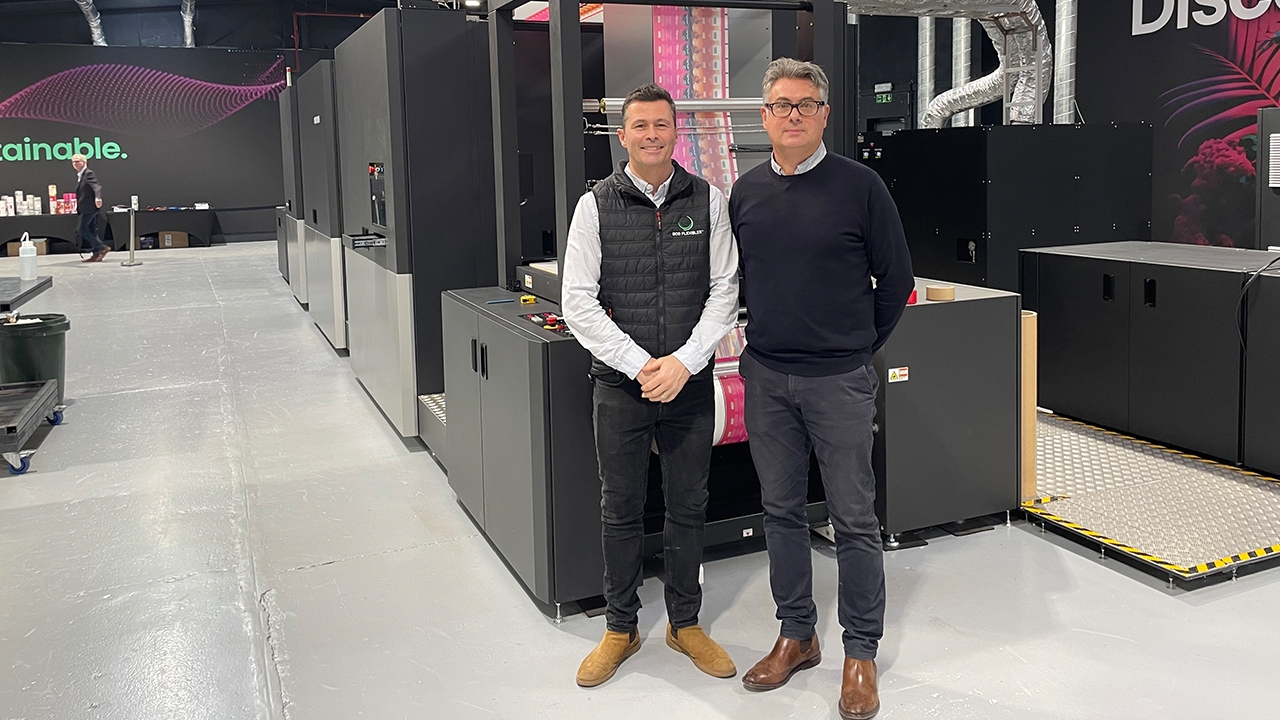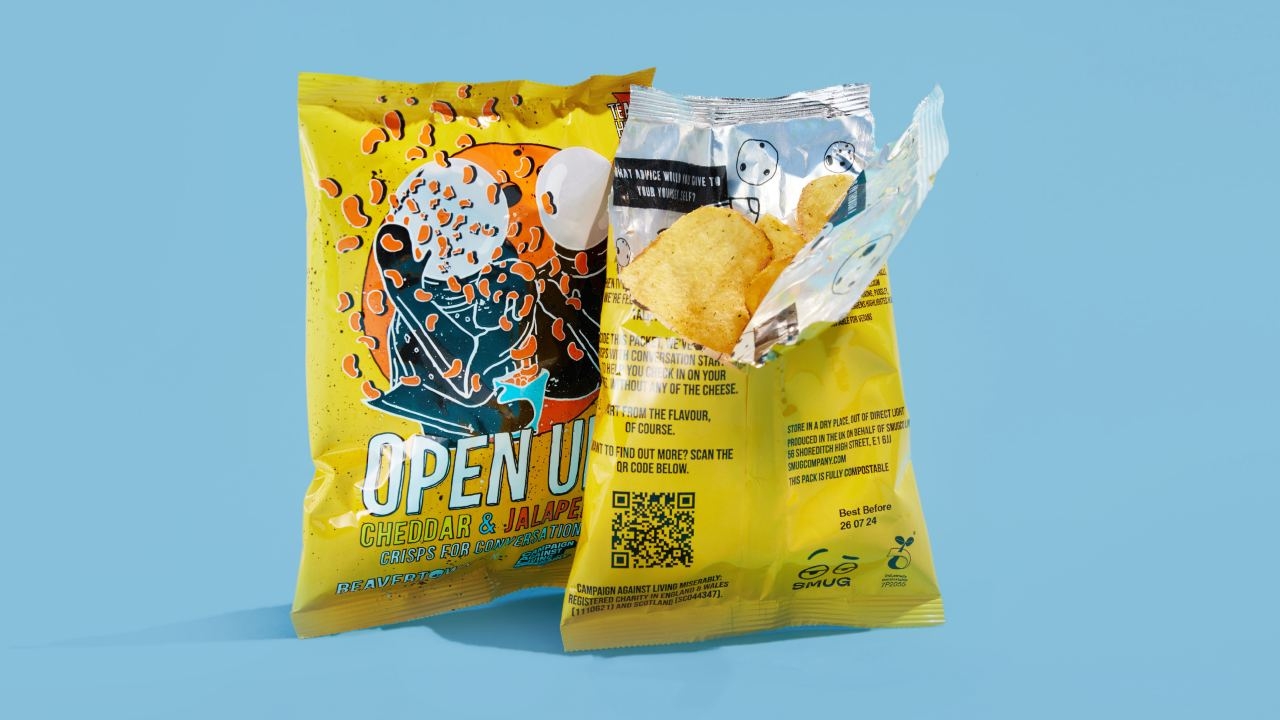Eco Flexibles installs first Fujifilm FP790 digital press
Fujifilm’s new FP790 water-based inkjet press has passed its beta testing and looks set to further disrupt the flexible packaging market.

UK-based Eco Flexibles has taken the printing of flexible packaging in-house with the installation of the first Fujifilm Jet Press FP790 digital press outside Japan.
Located at Eco Flexibles’ new state-of-the-art 40,000sq ft factory in Northampton, the water-based inkjet FP790 will form a central part of the company’s sustainable flexible packaging pro position.
Eco Flexibles develops recyclable mono-polymer flexible packaging constructions that provide equivalent or improved performance over incumbent mixed plastic designs, as well as paper-based packaging.
The Jet Press FP790 press was installed at Eco Flexibles in August 2023 and completed beta testing in December. It is now operating commercially over two shifts. With capacity rapidly filling up, a second press is already planned.
Jet Press FP790
The Jet Press FP790 reverse and surface prints (on films and paper) in CMYK+ double white at 50m/min (164ft/min) on a 790mm (31in) wide web with a print width between 520 – 733mm (20.5 – 28.9in).
The 1,200 x 1,200 DPI inkjet heads jet from heavy coverage down to 2pt positive type and 3pt negative text.
The press has been qualified to print on 12-40 micron PET, BOPP and paper, and Fujifilm says most common flexible packaging materials can be used after preliminary testing. Registration is automatically controlled within +/- 0.15mm (5.9thou).
The press has three coating and print towers. The first is a web conditioning station incorporating corona treatment and flexo coater applying a water-based primer, followed by heat drying boxes and chilled roll. The primer is used to improve ink anchorage on plastic films.
The second tower houses the CMYK print heads on a retractable rig with automatic head cleaning. The pigmented water-based inks were developed by Fujifilm with a high color density which allows over 90 percent of Pantone colors to be matched with just four colors. Again, there are powerful heat boxes to dry the inks followed by a chill drum.
The third tower is for the double white inks, which Fujifilm says outperforms flexo with a combined opacity of 55-58 percent.
CMYK+W inks are compliant with a range of food contact regulations including Nestlé, Swiss Ordinance, EuPIA guidelines, EU regulatory framework, GMP and FDA. The inks are currently manufactured in Japan, but manufacturing is likely to be rolled out to the US and Europe in the future.
After the inkjet unit, is an integrated inspection tower delivering 100 percent defect detection and automatic nozzle compensation to prevent the appearance of white lines in the event of a blocked nozzle.
Niche positioning
Eco Flexibles is an excellent example of how the Jet Press FP790 could further disrupt the flexible packaging market.
The company has two main divisions: Creation, a repro/ platemaking house; and Eco Flexibles, a supplier of sustainable flexible packaging films. In the past, Eco Flexibles outsourced the printing and laminating of these films to wide web flexible packaging converters.
Interestingly, it was through Creation, the platemaking side of the business, that Eco Flexibles first came into contact with Fujifilm through an investment in Flenex water-based plates and processors in 2021. Flenex forms a core plank of Creation’s ‘net zero’ reprographics offering.
‘A wider conversation about the future of sustainable production led to a trip to Japan where we introduced Eco Flexibles to the Jet Press FP790,’ recalls Manuel Schrutt, head of packaging at Fujifilm EMEA.
Says Simon Buswell, director of Eco Flexibles: ‘Our initial focus was on materials development for sustainability, but we always said we would start printing ourselves if the right technology came along. There was no way we were going to set up a flexo operation. Flexo is more about volume, and we could see run lengths were coming down and the number of SKUs increasing, which means more make readies and waste in a flexo operation. Our end customers are also facing supply chain issues with the need to reduce inventories. Also, we did not want to be handling solvents. Then Fujifilm started talking about bringing to market this water-based inkjet press that would fit into a standard flexible packaging workflow – that bridges flexo and digital – and would fit perfectly into our sustainability strategy.’
The Jet Press FP790 was developed from the ground up to fit seamlessly into existing industry workflows. ‘This is where we are different from digital-only suppliers - Fujifilm comes from the analog world of inks, LED curing systems and plates,’ says Manuel Schrutt. ‘This press is designed to fit into a mainstream flexible packaging workflow, to print mainstream flexo jobs at rotogravure quality and fit into existing production processes. Jobs can be laminated with the same laminator and go to the same pouch-making machine. Digital today needs to answer mainstream questions - so this is a different approach.’
Fujifilm developed the FP790 press along with key industry partners Henkel, Nordmeccanica, Karville and Hybrid.
‘We extensively tested Henkel’s portfolio of laminating adhesives to ensure compatibility on the Nordmeccanica laminator,’ says Schrutt. ‘And we worked with Karlville to ensure these laminates would work seamlessly on its pouch-making machine.’
Eco Flexibles installed a Nordmeccanica laminator, Ashe slitter/rewinder and a Karlville pouch-making machine along with the FP790 press.
On the digital side, Fujifilm was able to use its experience developing the Jet Press 750S for the folding carton and board market, powered by similar 1,200 x 1,200 DPI Samba inkjet printheads. The company had also developed press-wide inkjet print bars for retrofitting to flexo presses or other analog processes.
Fujifilm engineers worked with Hybrid to develop the digital front end (DFE) for the FP790. Hybrid’s PackZ PDF editing software allows for the addition of trapping, white creation, dieline control, imposition and overprint control. Communication with the FP790 print controller is through Hybrid’s web-based Cloudflow software, with Global Graphics’ HQ-Direct providing RIPing to print. Infigo provides web-to-print software.
Jet Press in operation
‘This is a transformative moment for the flexible packaging industry in the UK,
and for us as a business,’ enthuses Simon Buswell. ‘Our mission is to make recyclable monopolymer and paper packaging more accessible for brand owners, and with this multi-million-pound investment, we’re providing our customers with digital press technology with all the benefits that it attracts – very short run and variable data printing, fast turnaround and outstanding graphic performance that more than rivals traditional analog print techniques. We are setting a new benchmark in quality and sus taina bility.’
All the materials sent down the press and through the lamination line have performed flawlessly, says Buswell, ‘with good peals and seals and meeting our customers’ shelf-life requirements.’
Eco Flexibles worked hard to bring its brand customers on this journey. ‘It is a question of cost versus speed. Brands will be paying more for inkjet compared to flexo or gravure, but they will get the job more quickly, in just the quantities they want, in gravure quality and with no waste.’
With its existing group expertise in reprographics, Eco Flexibles is in a position to color manage jobs between the Jet Press FP790 press and both flexo and gravure presses.
‘This would mean, for example, that brands starting with multiple SKUs on
the digital press could ramp up to mass production on gravure or flexo and we can color manage this whole process,’ says Buswell. ‘The print quality of our digital press matches gravure and we can adjust the output quality to match flexo as well.’
Fujifilm’s Manuel Schrutt presented figures that confirm the multiple forces pushing towards shorter runs in the flexible packaging market: more packaging redesigns, more multi-SKU orders and more regulatory changes requiring packaging design changes. ‘All this is likely to lead to excess inventory, which is a major cause of waste.’
Schrutt noted an 8-fold increase in Print samples redesign work since 2018, with multi-SKU jobs increasing to over one-third of all jobs in 2022 compared to just 7 percent in 2018.
Much of this shorter-run work is being driven by challenger brands which are now outgrowing the established brands in the UK market.
Schrutt estimates that this has driven average flexible packaging run lengths down to an average of 8,000sqm.
This chimes with Eco Flexibles’ experience to date, with average run lengths on the FP790 of 5,000 linear meters, two to three across.
‘The press is very productive because of the width and speed,’ explains Matt Francklow, director of Eco Flexibles. ‘We are printing a total of 35,000sqm a day on just one shift with an OEE in the very high 80s. We can also print multiple SKUs across the web for additional efficiency. If required, we can print longer runs up to around half of an average flexo press run at a matching or greater quality level.’
Francklow says jobs as long as 20,000sqm are not unusual.
Going forward, both Schrutt and the two Eco Flexibles directors see huge potential for further development in the water-based inkjet technology. For example, although the FP790 is rated at 50m/min, the press has been run considerably faster in trials. Matt Francklow also envisages a big increase in jobs incorporating variable information once brands catch onto the potential for marketing outreach and track and trace. ‘This is only the beginning,’ concludes Schrutt.
Stay up to date
Subscribe to the free Label News newsletter and receive the latest content every week. We'll never share your email address.


